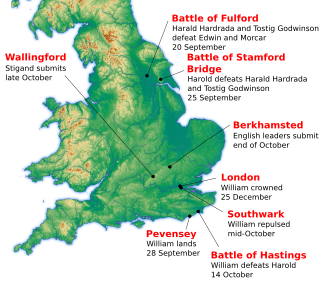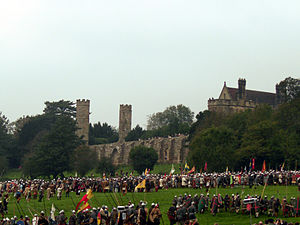
Ealdred was Abbot of Tavistock, Bishop of Worcester, and Archbishop of York in early medieval England. He was related to a number of other ecclesiastics of the period. After becoming a monk at the monastery at Winchester, he was appointed Abbot of Tavistock Abbey in around 1027. In 1046 he was named to the Bishopric of Worcester. Ealdred, besides his episcopal duties, served Edward the Confessor, the King of England, as a diplomat and as a military leader. He worked to bring one of the king's relatives, Edward the Exile, back to England from Hungary to secure an heir for the childless king.

Harold Godwinson, also called Harold II, was the last crowned Anglo-Saxon English king. Harold reigned from 6 January 1066 until his death at the Battle of Hastings, fighting the Norman invaders led by William the Conqueror during the Norman conquest of England. His death marked the end of Anglo-Saxon rule over England.

The Battle of Hastings was fought on 14 October 1066 between the Norman-French army of William, the Duke of Normandy, and an English army under the Anglo-Saxon King Harold Godwinson, beginning the Norman Conquest of England. It took place approximately 7 mi (11 km) northwest of Hastings, close to the present-day town of Battle, East Sussex, and was a decisive Norman victory.

The Bayeux Tapestry is an embroidered cloth nearly 70 metres (230 ft) long and 50 centimetres (20 in) tall that depicts the events leading up to the Norman Conquest of England in 1066, led by William, Duke of Normandy challenging Harold II, King of England, and culminating in the Battle of Hastings. It is thought to date to the 11th century, within a few years after the battle. It tells the story from the point of view of the conquering Normans but is now widely accepted to have been made in England.

The Battle of Stamford Bridge took place at the village of Stamford Bridge, East Riding of Yorkshire, in England, on 25 September 1066, between an English army under King Harold Godwinson and an invading Norwegian force led by King Harald Hardrada and the English king's brother Tostig Godwinson. After a bloody battle, both Hardrada and Tostig, along with most of the Norwegians, were killed. Although Harold Godwinson repelled the Norwegian invaders, his army was defeated by the Normans at Hastings less than three weeks later. The battle has traditionally been presented as symbolising the end of the Viking Age, although major Scandinavian campaigns in Britain and Ireland occurred in the following decades, such as those of King Sweyn Estrithson of Denmark in 1069–1070 and King Magnus Barefoot of Norway in 1098 and 1102–1103.

The Norman Conquest was the 11th-century invasion and occupation of England by an army made up of thousands of Norman, Breton, Flemish, and French troops, all led by the Duke of Normandy, later styled William the Conqueror.

Battle Abbey is a partially ruined Benedictine abbey in Battle, East Sussex, England. The abbey was built on the site of the Battle of Hastings and dedicated to St Martin of Tours. It is a Scheduled Monument.

Historical reenactment is an educational or entertainment activity in which mainly amateur hobbyists and history enthusiasts dress in historic uniforms or costumes and follow a plan to recreate aspects of a historical event or period. This may be as narrow as a specific moment from a battle, such as the reenactment of Pickett's Charge presented during the Great Reunion of 1913, or as broad as an entire period, such as Regency reenactment.

The Battle of Fulford was fought on the outskirts of the village of Fulford just south of York in England, on 20 September 1066, when King Harald III of Norway, also known as Harald Hardrada, and Tostig Godwinson, his English ally, fought and defeated the Northern Earls Edwin and Morcar.

American Civil War reenactment is an effort to recreate the appearance of a particular battle or other event associated with the American Civil War by hobbyists known as Civil War reenactors, or living historians.

Medieval reenactment is a form of historical reenactment that focuses on re-enacting European history in the period from the fall of Rome to about the end of the 15th century. The second half of this period is often called the Middle Ages. This multiplicity of terms is compounded by the variety of other terms used for the period.

The Battle of Waterloo reenactment is an annual modern recreation of the 19th century Battle of Waterloo on the original battlefield in Waterloo, Belgium.
The Vikings are a British-based society of historical re-enactors, dedicated to the study and re-enactment of the culture of the Viking Age (790–1066) and the display of authentic Dark Ages living history and combat.

Regia Anglorum, or simply Regia, is a Medieval reenactment organisation reenacting the life and times of the peoples who lived in and around the Islands of Britain from the time of Alfred the Great to Richard the Lionheart. Its members portray Anglo-Saxon, Viking, Norman and British living history from the period before the Norman Conquest. The society has gained in popularity as a result of being featured in prominent television programmes such as Michael Wood on Beowulf, Time Team and A History of Britain.
Classical reenactment tends to focus on portrayals of the Greco-Roman world, and especially on modern recreations of Roman legions and ancient Greek hoplites.
Historical re-enactment in Australia has been occurring since at least the early 1970s. With no conventional land battles and few protracted civil disturbances since the British colonisation of Australia, most military re-enactment in Australia focuses on events from other countries, including the European Feudal, medieval, and renaissance eras.
William I of England has been depicted in a number of modern works.

The 1066 Country Walk is a waymarked long-distance footpath or recreational walk in southern England, United Kingdom.

The Battle of Grolle is a regular historical reenactment of the siege of the fortified border town of Groenlo in the Achterhoek in 1627 during the Dutch Revolt. It is held in and around Groenlo itself every two years. The event lasts for three days and features a historic battle reenactment and a historic fair, with reenactors from many European countries. During the event, the reenactors try to relive the conditions of 1627 as faithfully as possible, without electricity or heating, while eating traditional food.

Neil Clephane-Cameron is a historian, writer and actor from Battle, East Sussex. Much of his work is centred on research into the events of 1066, in particular the Battle of Hastings. He has appeared as a consultant historian in a number of BBC documentaries, and cowrote the nonfiction book The 1066 Malfosse Walk with Joanne Lawrence in 2000. Other periods of particular interest to him are the English Civil War and World War I. Clephane-Cameron has also conducted guided tours, for individuals and groups such as The Battlefields Trust, of battlefields in Britain and Europe including Hastings, 1066; Lewes, 1264; Waterloo, 1815; 1st Ypres, 1914; The Somme, 1916.

















